Abstract
To assess the effects of crystalloid and colloid resuscitation on hemodynamic response and on lung water following thermal injury, 79 patients were assigned randomly to receive lactated Ringer's solution or 2.5% albumin-lactated Ringer's solution. Crystalloid-treated patients required more fluid for successful resuscitation than did those receiving colloid solutions (3.81 vs. 2.98 ml/kg body weight/% body surface burn, p less than 0.01). In study phase 1 (29 patients), cardiac index and myocardial contractility (ejection fraction and mean rate of internal fiber shortening, Vcf) were determined by echocardiography during the first 48 hours postburn. Cardiac index was lower in the 12- to 24-hour postburn interval in the crystalloid group, but this difference between treatment groups had disappeared by 48 hours postburn. Ejection fractions were normal throughout the entire study, while Vcf was supranormal (p less than 0.01 vs. normals) and equal in the two resuscitation groups. In study phase 2 (50 patients), extravascular lung water and cardiac index were measured by a standard rebreathing technique at least daily for the first postburn week. Lung water remained unchanged in the crystalloid-treated patients (p greater than 0.10), but progressively increased in the colloid-treated patients over the seven day study (p less than 0.0001). The measured lung water in each treatment group was significantly different from one another (p less than 0.001). Cardiac index increased progressively and identically in both treatment groups over the study period (p less than 0.01). These data refute the existence of myocardial depression during postburn resuscitation and document hypercontractile left ventricular performance. The addition of colloid to crystalloid resuscitation fluids produces no long lasting benefit on total body blood flow, and promotes accumulation of lung water when edema fluid is being reabsorbed from the burn wound.
Full text
PDF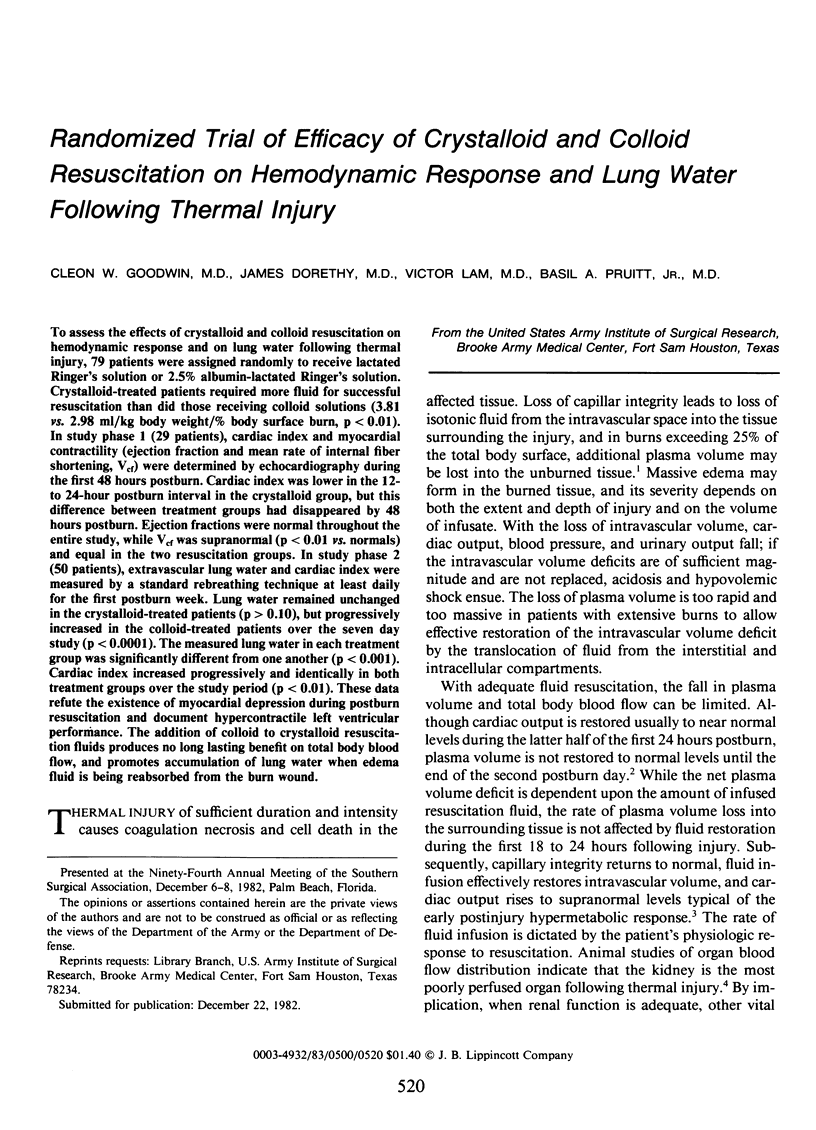
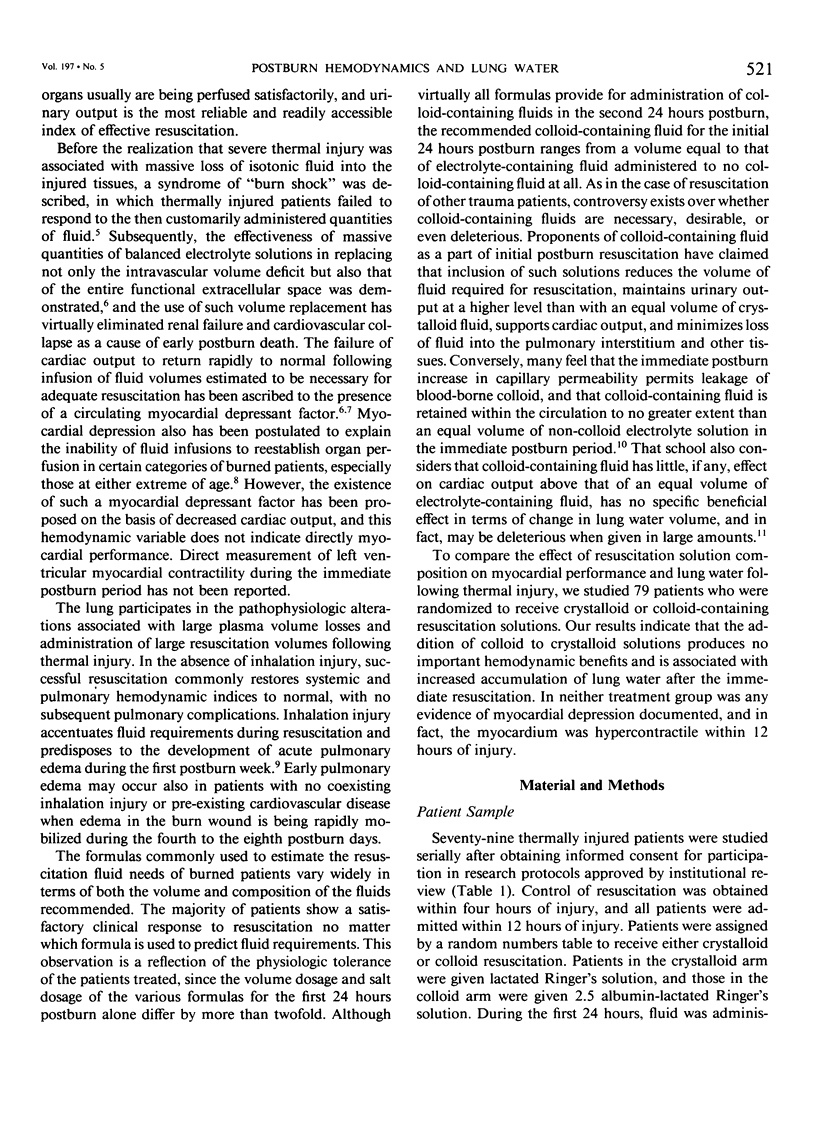
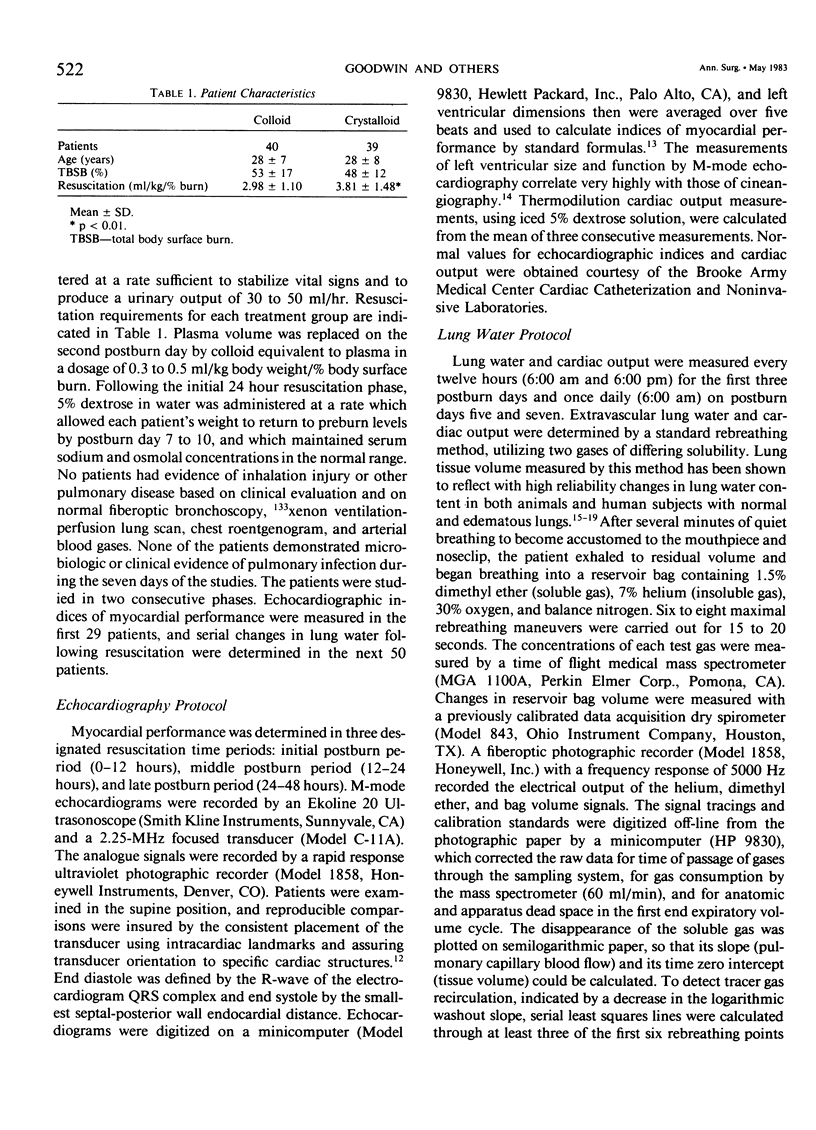
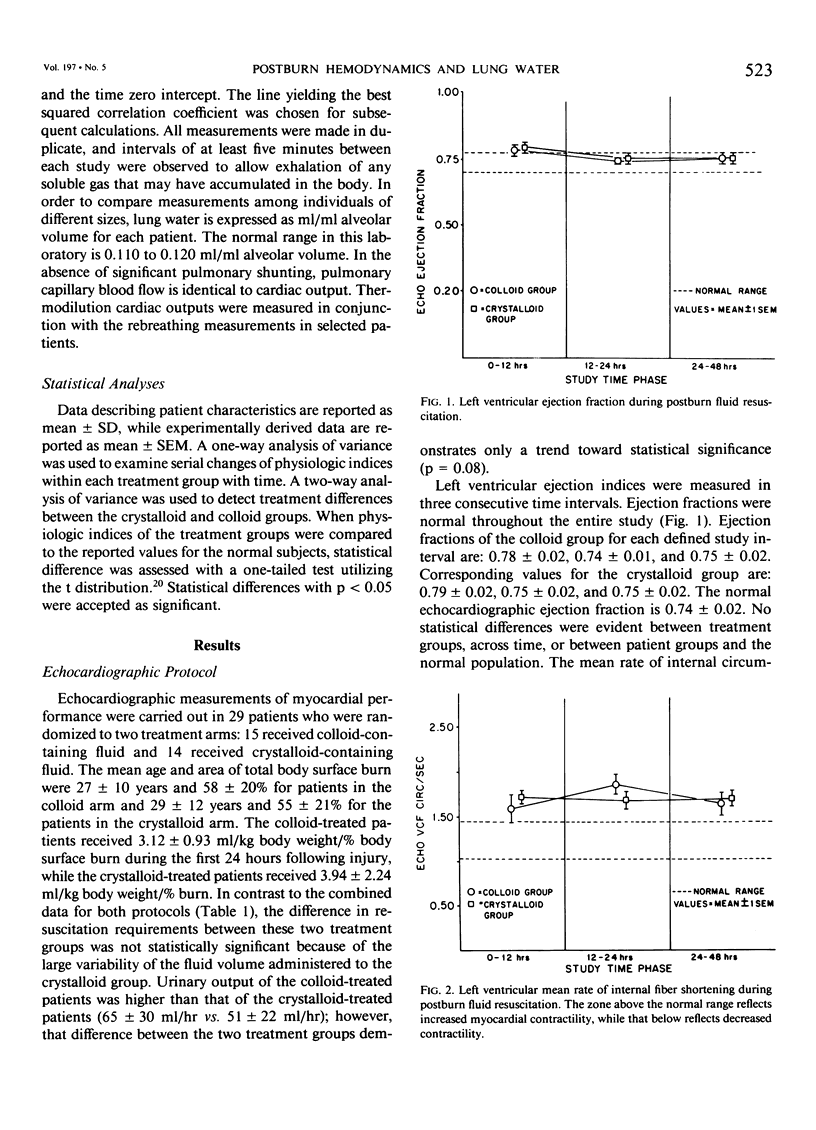
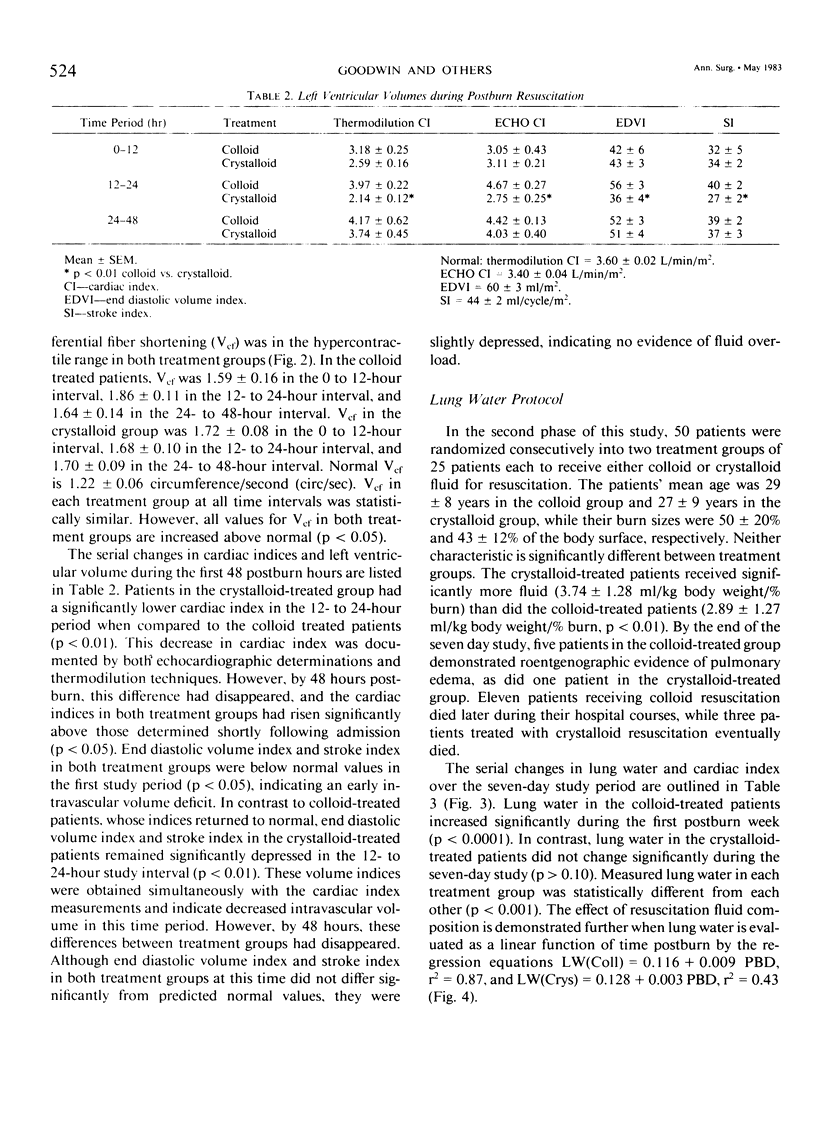
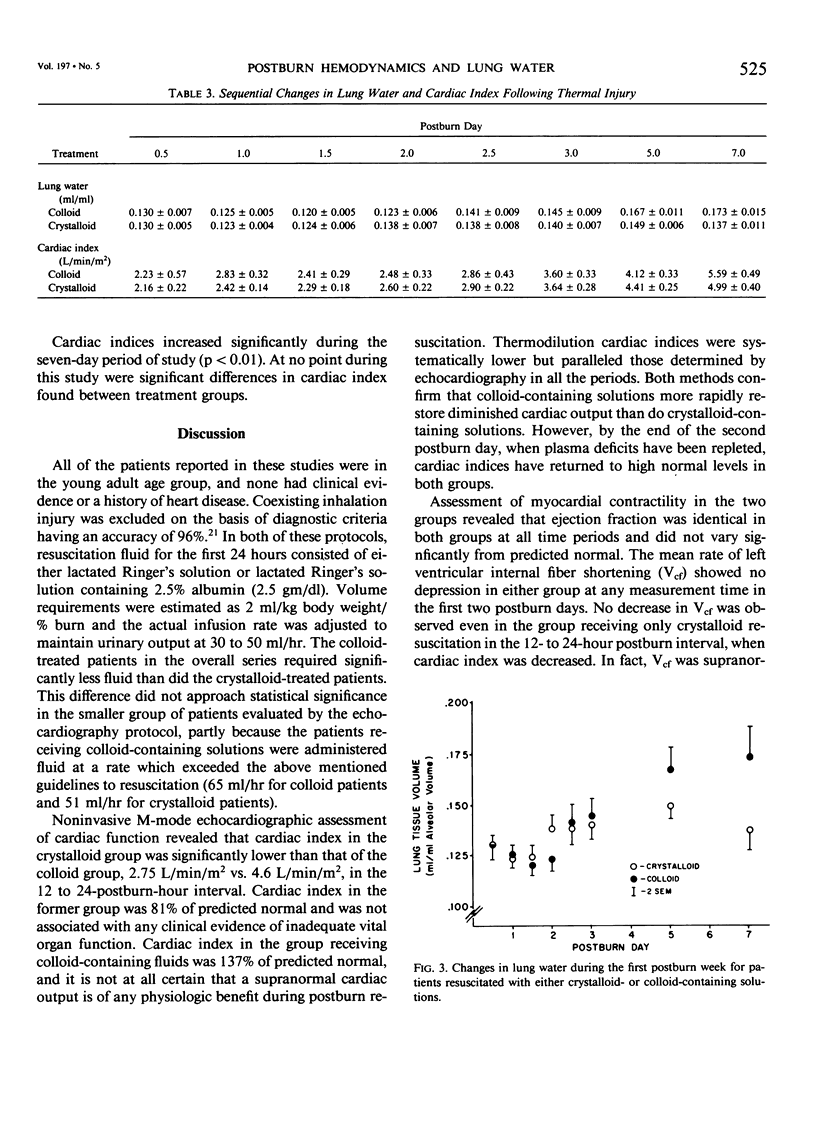
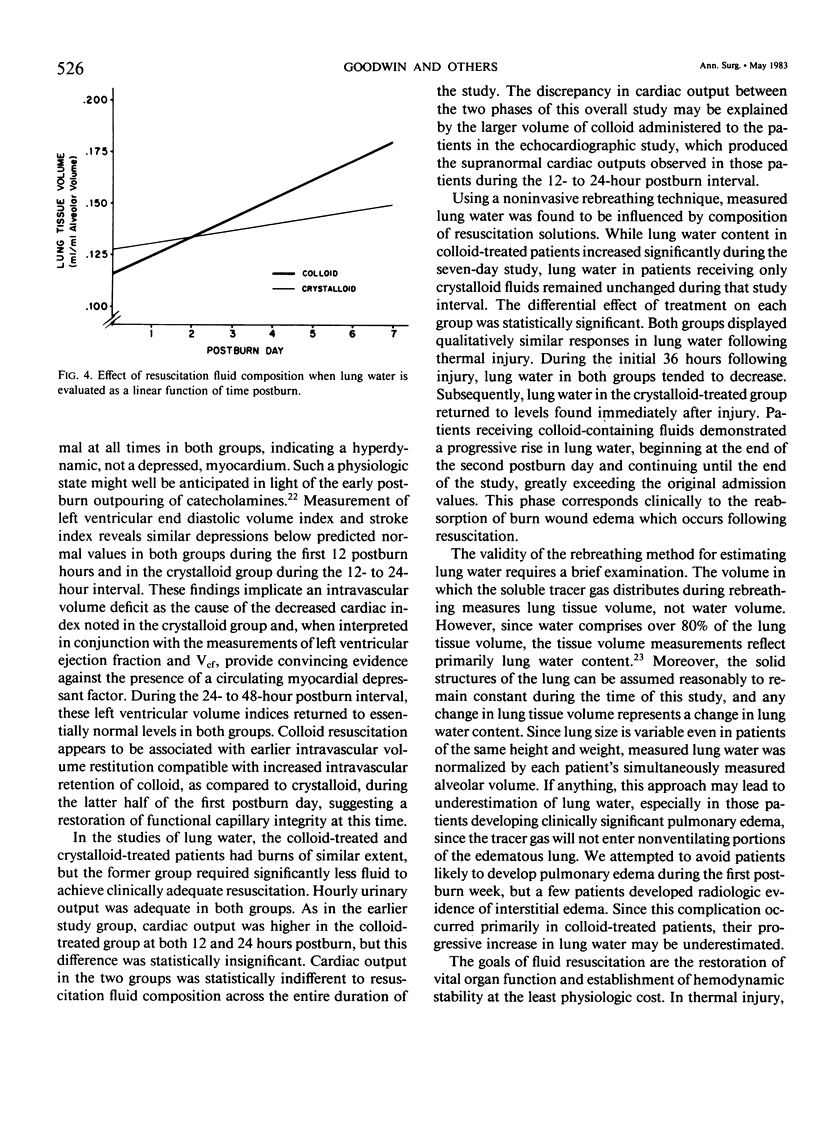
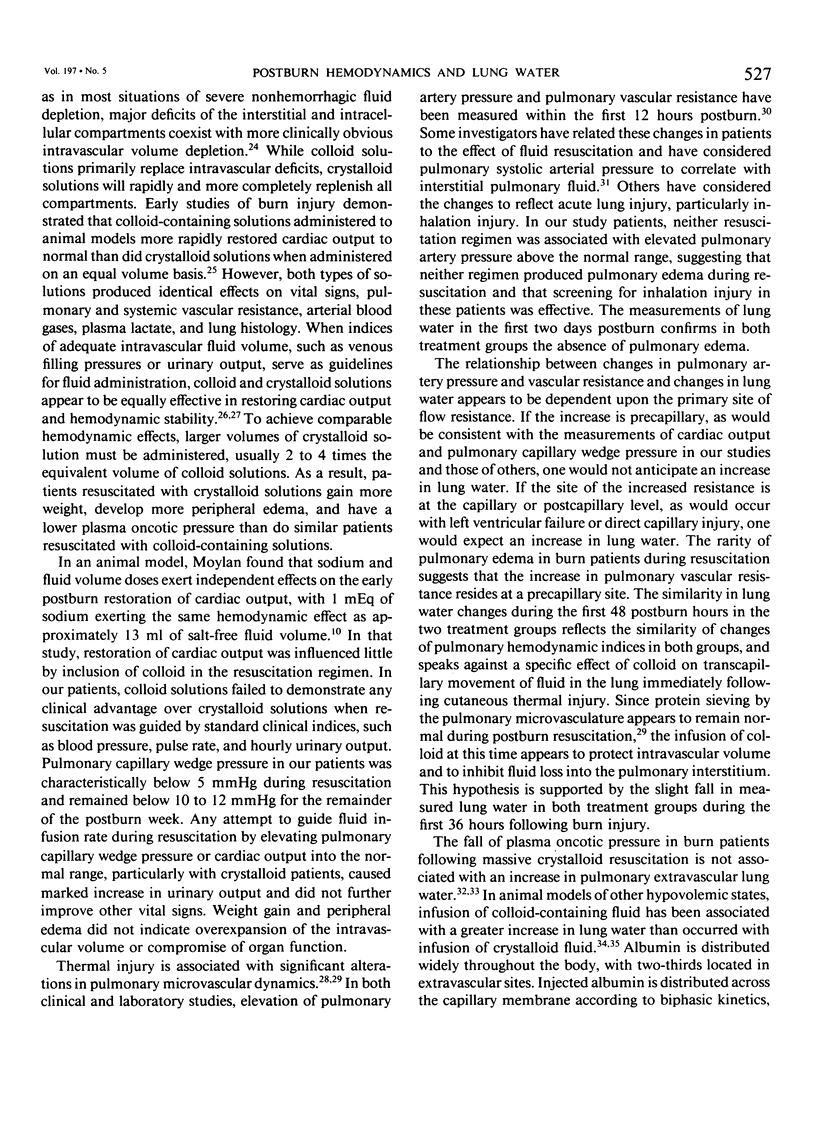
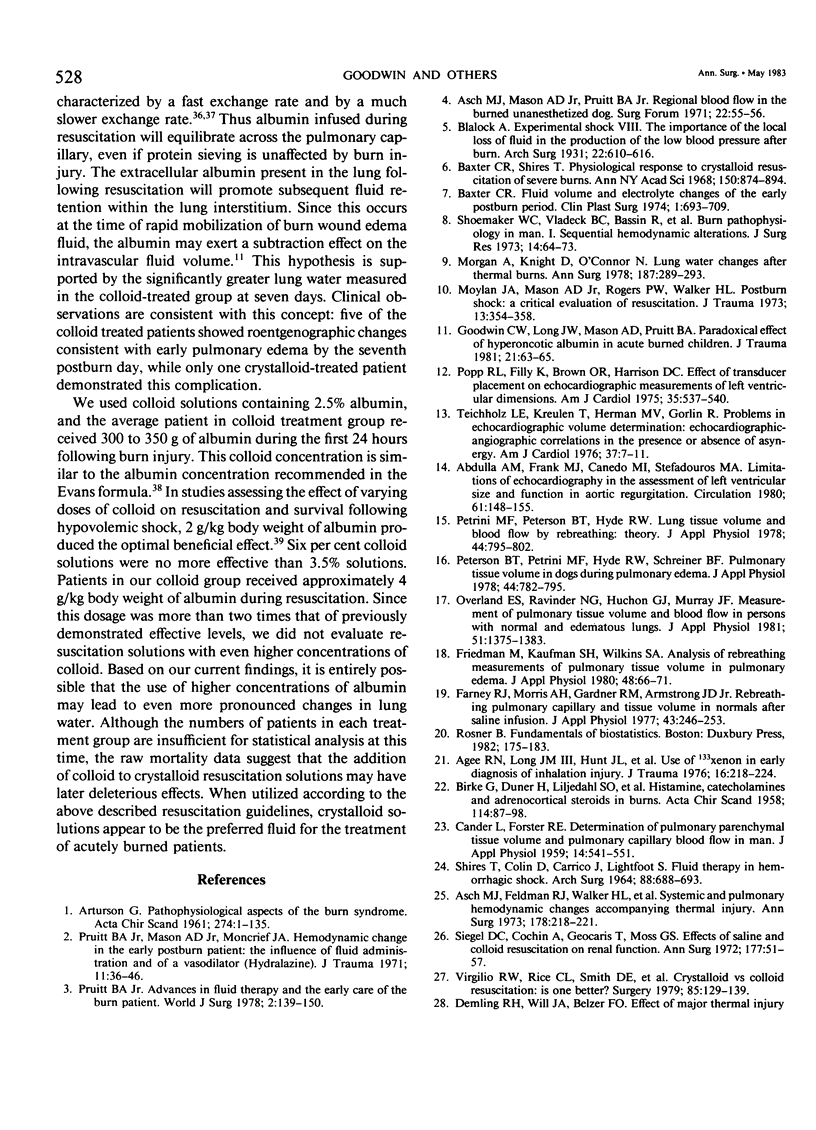
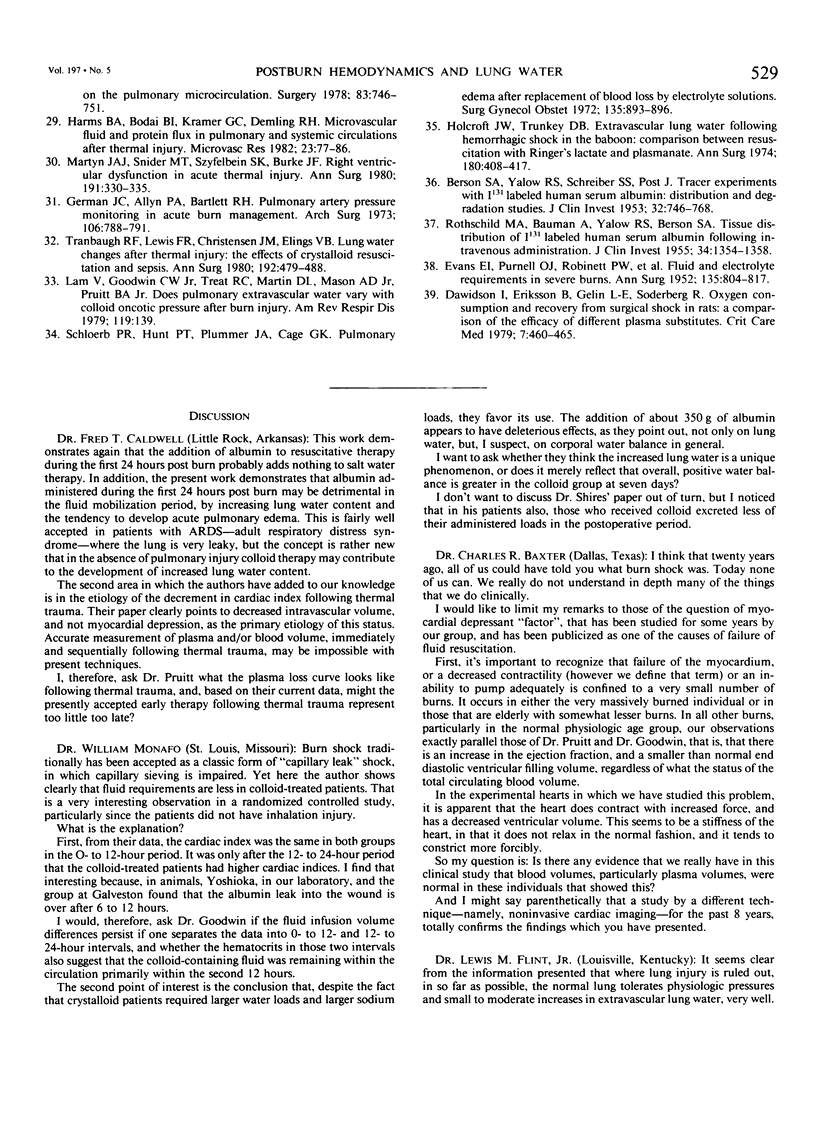
Selected References
These references are in PubMed. This may not be the complete list of references from this article.
- ARTURSON G. Pathophysiological aspects of the burn syndrome with special reference to liver injury and alterations of capillary permeability. Acta Chir Scand Suppl. 1961;Suppl 274:1–135. [PubMed] [Google Scholar]
- Abdulla A. M., Frank M. J., Canedo M. I., Stefadouros M. A. Limitations of echocardiography in the assessment of left ventricular size and function in aortic regurgitation. Circulation. 1980 Jan;61(1):148–155. doi: 10.1161/01.cir.61.1.148. [DOI] [PubMed] [Google Scholar]
- Agee R. N., Long J. M., 3rd, Hunt J. L., Petroff P. A., Lull R. J., Mason A. D., Jr, Pruitt B. A., Jr Use of 133xenon in early diagnosis of inhalation injury. J Trauma. 1976 Mar;16(3):218–224. doi: 10.1097/00005373-197603000-00007. [DOI] [PubMed] [Google Scholar]
- Asch M. J., Feldman R. J., Walker H. L., Foley F. D., Popp R. L., Mason A. D., Jr, Pruitt B. A., Jr Systemic and pulmonary hemodynamic changes accompanying thermal injury. Ann Surg. 1973 Aug;178(2):218–221. doi: 10.1097/00000658-197308000-00020. [DOI] [PMC free article] [PubMed] [Google Scholar]
- Asch M. J., Meserol P. M., Mason A. D., Jr, Pruitt B. A., Jr Regional blood flow in the burned unanesthetized dog. Surg Forum. 1971;22:55–56. [PubMed] [Google Scholar]
- BERSON S. A., YALOW R. S., SCHREIBER S. S., POST J. Tracer experiments with I131 labeled human serum albumin: distribution and degradation studies. J Clin Invest. 1953 Aug;32(8):746–768. doi: 10.1172/JCI102789. [DOI] [PMC free article] [PubMed] [Google Scholar]
- BIRKE G., DUNER H., LILJEDAHL S. O., PERNOW B., PLANTIN L. O., TROELL L. Histamine, catechol amines and adrenocortical steroids in burns. Acta Chir Scand. 1958 Jan 31;114(2):87–98. [PubMed] [Google Scholar]
- Baxter C. R. Fluid volume and electrolyte changes of the early postburn period. Clin Plast Surg. 1974 Oct;1(4):693–703. [PubMed] [Google Scholar]
- Baxter C. R., Shires T. Physiological response to crystalloid resuscitation of severe burns. Ann N Y Acad Sci. 1968 Aug 14;150(3):874–894. doi: 10.1111/j.1749-6632.1968.tb14738.x. [DOI] [PubMed] [Google Scholar]
- Dawidson I., Eriksson B., Gelin L. E., Söderberg R. Oxygen consumption and recovery from surgical shock in rats: a comparison of the efficacy of different plasma substitutes. Crit Care Med. 1979 Oct;7(10):460–465. doi: 10.1097/00003246-197910000-00004. [DOI] [PubMed] [Google Scholar]
- Demling R. H., Will J. A., Belzer F. O. Effect of major thermal injury on the pulmonary microcirculation. Surgery. 1978 Jun;83(6):746–751. [PubMed] [Google Scholar]
- EVANS E. I., PURNELL O. J., ROBINETT P. W., BATCHELOR A., MARTIN M. Fluid and electrolyte requirements in severe burns. Ann Surg. 1952 Jun;135(6):804–817. doi: 10.1097/00000658-195206000-00006. [DOI] [PMC free article] [PubMed] [Google Scholar]
- Farney R. J., Morris A. H., Gardner R. M., Armstrong J. D., Jr Rebreathing pulmonary capillary and tissue volume in normals after saline infusion. J Appl Physiol Respir Environ Exerc Physiol. 1977 Aug;43(2):246–253. doi: 10.1152/jappl.1977.43.2.246. [DOI] [PubMed] [Google Scholar]
- Friedman M., Kaufman S. H., Wilkins S. A., Jr Analysis of rebreathing measurements of pulmonary tissue volume in pulmonary edema. J Appl Physiol Respir Environ Exerc Physiol. 1980 Jan;48(1):66–71. doi: 10.1152/jappl.1980.48.1.66. [DOI] [PubMed] [Google Scholar]
- German J. C., Allyn P. A., Barlett R. H. Pulmonary artery pressure monitoring in acute burn management. Arch Surg. 1973 Jun;106(6):788–791. doi: 10.1001/archsurg.1973.01350180028010. [DOI] [PubMed] [Google Scholar]
- Goodwin C. W., Long J. W., 3rd, Mason A. D., Jr, Pruitt B. A., Jr Paradoxical effect of hyperoncotic albumin in acutely burned children. J Trauma. 1981 Jan;21(1):63–65. doi: 10.1097/00005373-198101000-00014. [DOI] [PubMed] [Google Scholar]
- Harms B. A., Bodai B. I., Kramer G. C., Demling R. H. Microvascular fluid and protein flux in pulmonary and systemic circulations after thermal injury. Microvasc Res. 1982 Jan;23(1):77–86. doi: 10.1016/0026-2862(82)90032-2. [DOI] [PubMed] [Google Scholar]
- Holcroft J. W., Trunkey D. D. Extravascular lung water following hemorrhagic shock in the baboon: Comparison between resuscitation with Ringer's lactate and Plasmanate. Ann Surg. 1974 Oct;180(4):408–417. doi: 10.1097/00000658-197410000-00005. [DOI] [PMC free article] [PubMed] [Google Scholar]
- Keens T. G., Ianuzzo C. D. Development of fatigue-resistant muscle fibers in human ventilatory muscles. Am Rev Respir Dis. 1979 Feb;119(2 Pt 2):139–141. doi: 10.1164/arrd.1979.119.2P2.139. [DOI] [PubMed] [Google Scholar]
- Martyn J. A., Snider M. T., Szyfelbein S. K., Burke J. F., Laver M. B. Right ventricular dysfunction in acute thermal injury. Ann Surg. 1980 Mar;191(3):330–335. doi: 10.1097/00000658-198003000-00012. [DOI] [PMC free article] [PubMed] [Google Scholar]
- Morgan A., Knight D., O'Connor N. Lung water changes after thermal burns. An observational study. Ann Surg. 1978 Mar;187(3):288–293. doi: 10.1097/00000658-197803000-00013. [DOI] [PMC free article] [PubMed] [Google Scholar]
- Moylan J. A., Mason A. D., Jr, Rogers P. W., Walker H. L. Postburn shock: a critical ealuation of resuscitation. J Trauma. 1973 Apr;13(4):354–358. [PubMed] [Google Scholar]
- Overland E. S., Gupta R. N., Huchon G. J., Murray J. F. Measurement of pulmonary tissue volume and blood flow in persons with normal and edematous lungs. J Appl Physiol Respir Environ Exerc Physiol. 1981 Dec;51(6):1375–1383. doi: 10.1152/jappl.1981.51.6.1375. [DOI] [PubMed] [Google Scholar]
- Peterson B. T., Petrini M. F., Hyde R. W., Schreiner B. F. Pulmonary tissue volume in dogs during pulmonary edema. J Appl Physiol Respir Environ Exerc Physiol. 1978 May;44(5):782–795. doi: 10.1152/jappl.1978.44.5.782. [DOI] [PubMed] [Google Scholar]
- Petrini M. F., Peterson B. T., Hyde R. W. Lung tissue volume and blood flow by rebreathing theory. J Appl Physiol Respir Environ Exerc Physiol. 1978 May;44(5):795–802. doi: 10.1152/jappl.1978.44.5.795. [DOI] [PubMed] [Google Scholar]
- Popp R. L., Filly K., Brown O. R., Harrison D. C. Effect of transducer placement on echocardiographic measurement of left ventricular dimensions. Am J Cardiol. 1975 Apr;35(4):537–540. doi: 10.1016/0002-9149(75)90837-1. [DOI] [PubMed] [Google Scholar]
- Pruitt B. A., Jr Advances in fluid therapy and the early care of the burn patient. World J Surg. 1978 Mar;2(2):139–150. doi: 10.1007/BF01553536. [DOI] [PubMed] [Google Scholar]
- Pruitt B. A., Jr, Mason A. D., Jr, Moncrief J. A. Hemodynamic changes in the early postburn patient: the influence of fluid administration and of a vasodilator (hydralazine). J Trauma. 1971 Jan;11(1):36–46. doi: 10.1097/00005373-197101000-00003. [DOI] [PubMed] [Google Scholar]
- ROTHSCHILD M. A., BAUMAN A., YALOW R. S., BERSON S. A. Tissue distribution of I131 labeled human serum albumin following intravenous administration. J Clin Invest. 1955 Sep;34(9):1354–1358. doi: 10.1172/JCI103183. [DOI] [PMC free article] [PubMed] [Google Scholar]
- SHIRES T., COLN D., CARRICO J., LIGHTFOOT S. FLUID THERAPY IN HEMORRHAGIC SHOCK. Arch Surg. 1964 Apr;88:688–693. doi: 10.1001/archsurg.1964.01310220178027. [DOI] [PubMed] [Google Scholar]
- Schloerb P. R., Hunt P. T., Plummer J. A., Cage G. K. Pulmonary edema after replacement of blood loss by electrolyte solutions. Surg Gynecol Obstet. 1972 Dec;135(6):893–896. [PubMed] [Google Scholar]
- Shoemaker W. C., Vladeck B. C., Bassin R., Printen K., Brown R. S., Amato J. J., Reinhard J. M., Kark A. E. Burn pathophysiology in man. I. Sequential hemodynamic alterations. J Surg Res. 1973 Jan;14(1):64–73. doi: 10.1016/0022-4804(73)90011-5. [DOI] [PubMed] [Google Scholar]
- Siegel D. C., Cochin A., Geocaris T., Moss G. S. Effects of saline and colloid resuscitation on renal function. Ann Surg. 1973 Jan;177(1):51–57. doi: 10.1097/00000658-197301000-00009. [DOI] [PMC free article] [PubMed] [Google Scholar]
- Teichholz L. E., Kreulen T., Herman M. V., Gorlin R. Problems in echocardiographic volume determinations: echocardiographic-angiographic correlations in the presence of absence of asynergy. Am J Cardiol. 1976 Jan;37(1):7–11. doi: 10.1016/0002-9149(76)90491-4. [DOI] [PubMed] [Google Scholar]
- Tranbaugh R. F., Lewis F. R., Christensen J. M., Elings V. B. Lung water changes after thermal injury. The effects of crystalloid resuscitation and sepsis. Ann Surg. 1980;192(4):479–490. doi: 10.1097/00000658-198010000-00007. [DOI] [PMC free article] [PubMed] [Google Scholar]
- Virgilio R. W., Rice C. L., Smith D. E., James D. R., Zarins C. K., Hobelmann C. F., Peters R. M. Crystalloid vs. colloid resuscitation: is one better? A randomized clinical study. Surgery. 1979 Feb;85(2):129–139. [PubMed] [Google Scholar]


